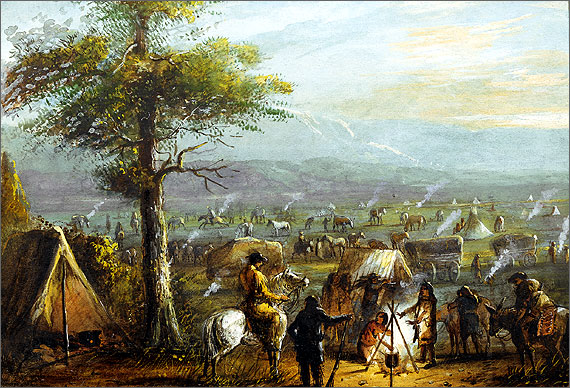Authors:
Historic Era:
Historic Theme:
Subject:
February 1956 | Volume 7, Issue 2


Authors:
Historic Era:
Historic Theme:
Subject:
February 1956 | Volume 7, Issue 2

In May, 1843, with the first greening of the prairie grass, a strange caravan, billed as a “Sporting Expedition to the West,” rolled spiritedly out from the Missouri frontier past tight-lipped groups of emigrant families grimly preparing what history would call the first great migration to Oregon. It was three years before Parkman, five and more before the California gold rush, and what was still to gain popular calling as the Oregon Trail had never before seen the likes of this train.
Ahead of the carls and wagons rode a company of wealthy young American bloods in fancy and expensive trappings, greenhorns with high-powered European rides, and whiskered sportsmen on high-headed buffalo runners, hung with burdensome equipment for the hunt. The outfit’s long column of pack mules and vehicles groaned under mounds of gay-colored tenting, India-rubber boats that would hold fifteen men, and costly, imported wines, liquors, potted meats, jams and other delicacies for a luxury outing. In the lend rode a beak-nosed, mustachioed Scottish nobleman, Sir William Drummond Stewart, the nineteenth of Grandtully and seventh baronet, and beside him an ill and aging veteran mountain man, the famous trapper of Washington Irving’s celebrated book, The Rocky Mountains , Colonel William Sublette.
“Individual gentlemen,” Sublette described the party in his journal, “Some of the armey, Some professional Gentlemen, Come on the trip for pleasure, Some for Health … doctors, Lawyers, botanists, Bugg Ketchers, Hunters and men of nearly all professions.’ More than half of the 93 members of the group, he added, were “hired men Belonging to Sir William.”
The expedition, bound in style for a summer holiday of pleasure and sport on the plains and in the Rocky Mountains, was of Sir William’s making. A veteran of Waterloo and a former captain in the Fifteenth (The King’s) Hussars, he had first come to the West in 1833 to hunt buffalo and to find high adventure. lie had spent six straight years in the West, living dangerously with mountain men and trappers and hilling in love with the wild beauty and freedom of the plains and mountains. In 1837, he had brought with him a Baltimore painter, Alfred Jacob Miller, to record grand views of the western wilderness to hang in his Scottish castle.
Upon the death of his older brother in 1838, Stewart had had to return to Scotland to assume the duties of his estate, but the memories of his happy years in the American West tugged strongly upon him, and gradually, in correspondence with Bill Sublette, he evolved the idea of returning once more, this time to lead a grand expedition